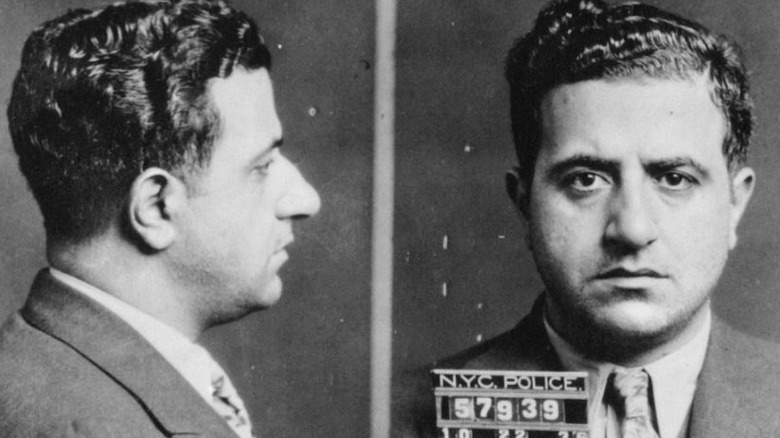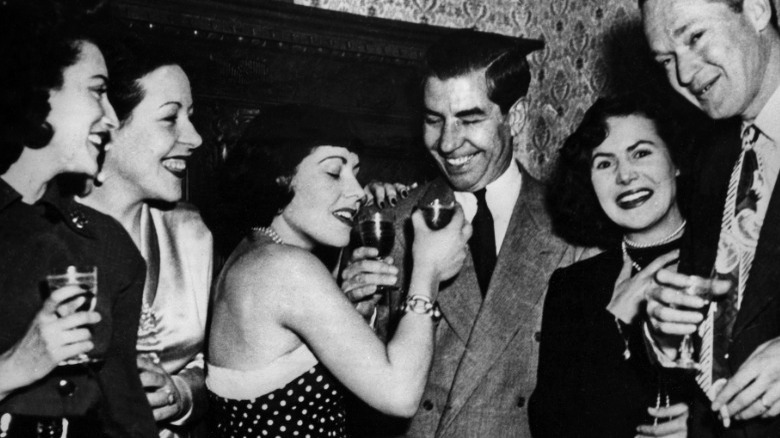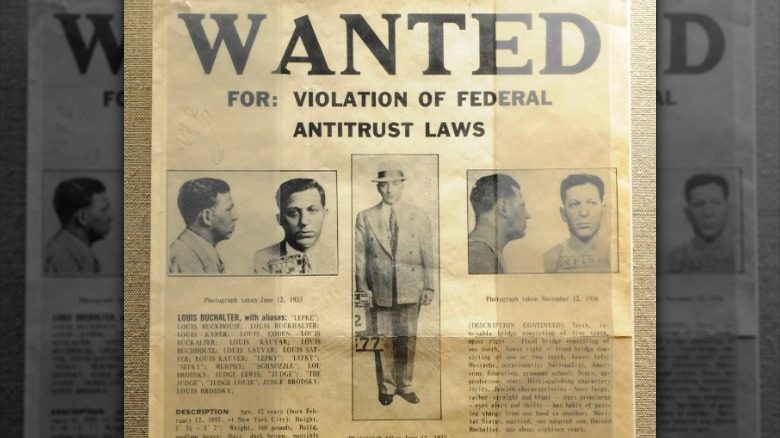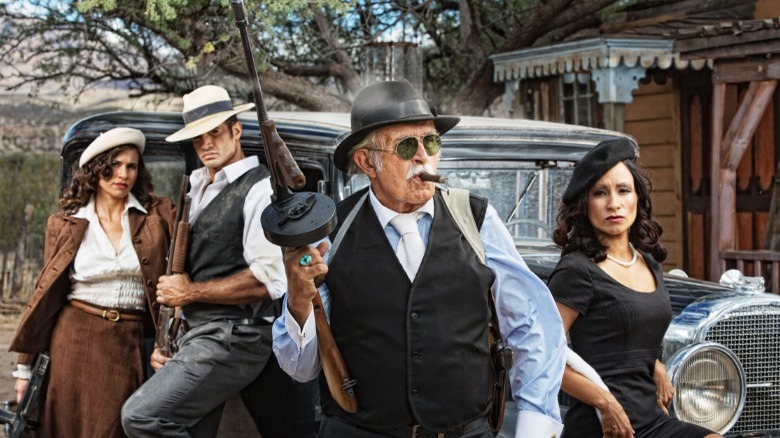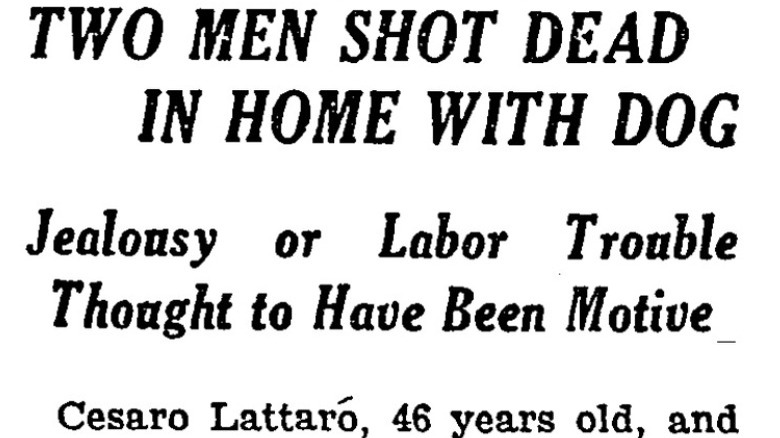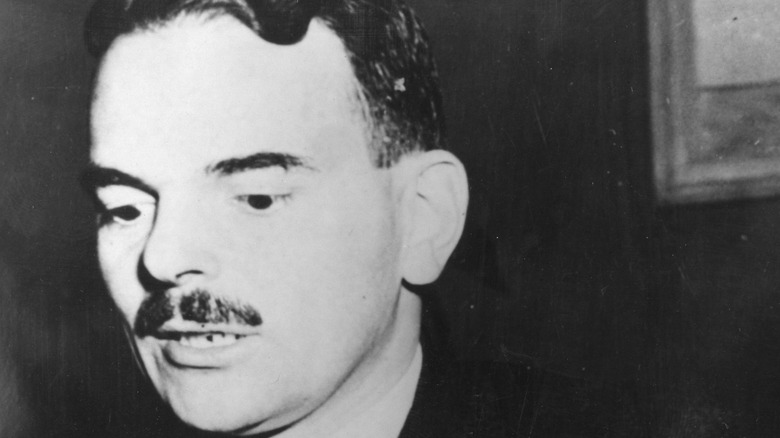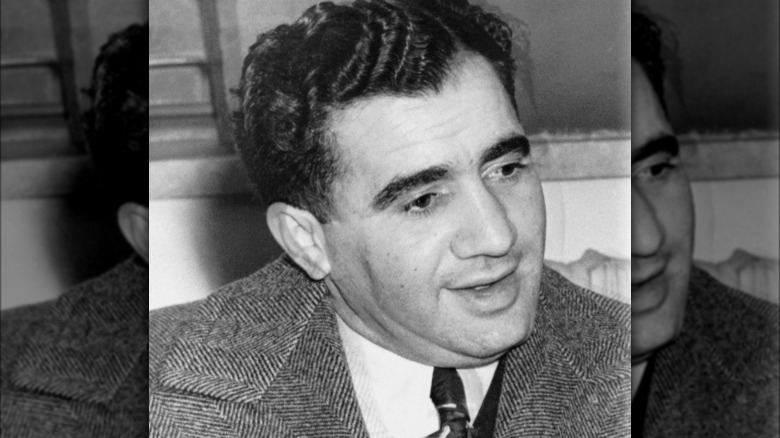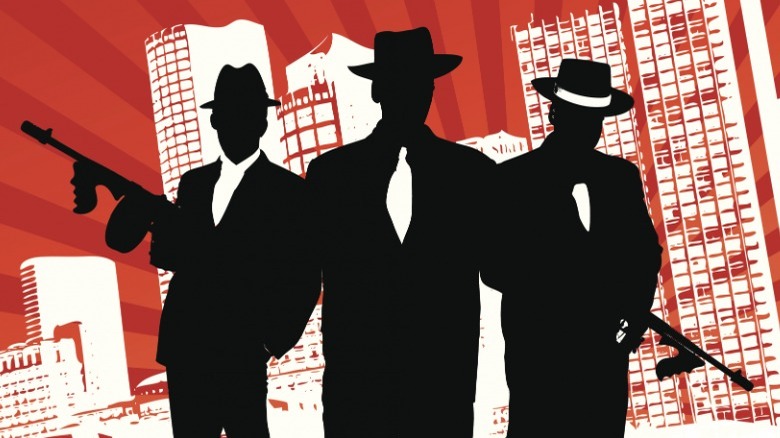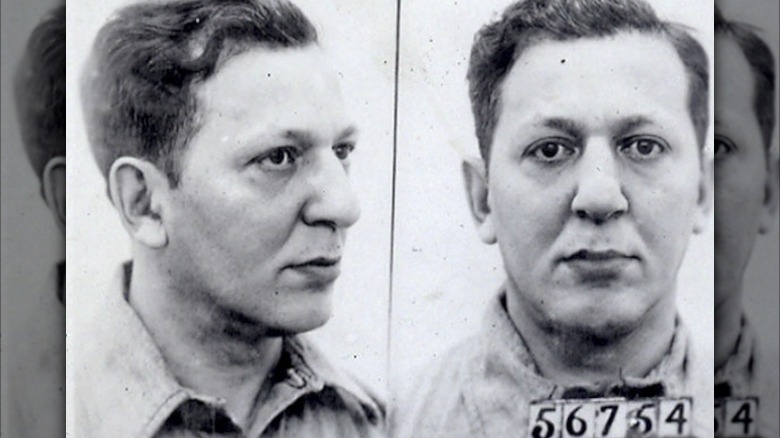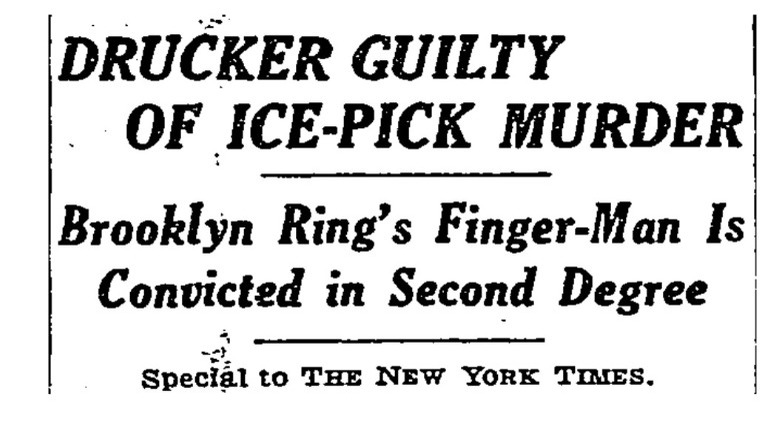Chilling Details About Mafia Hitmen, Murder, Inc.
Of all the notorious crime syndicates in American history, one of the infamous has to be that of Murder, Inc. As Britannica explains, the mobsters of Murder, Inc. were a group of assassins who spread terror throughout the United States in the 1930s. They were largely headed by Louis "Lepke" Buchalter and Albert Anastasia, and killing was their currency. They accepted contracts or hits on foes, and took them out in exceptionally brutal and violent ways.
If it had not been for the testimony of former member and turncoat Abe "Kid Twist" Reles, Murder, Inc. might have continued their ruthless ways for even longer. They have been implicated in hundreds of murders from their decade in business, and who knows just how frighteningly high the real amount could be.
According to The Mob Museum, the hitmen in Murder, Inc. were largely of Jewish or Italian origin, and they were willing to take on pretty much anyone — just as long as the price was right. Based largely in Brooklyn, New York, even the seedy underworld was afraid of what these gangsters were capable of. Though the members of the group have long since passed away, their memories still haunt the streets and cemeteries of New York — and elsewhere. These are the most chilling details about mafia hitmen, Murder, Inc.
Lucky Luciano helped create Murder, Inc.
In the late-1920s, one of the most powerful and notorious bosses in the entire American mob was a man known as Salvatore Maranzano. As Carl Sifakis explains in "The Mafia Encyclopedia," by the end of the decade, Maranzano and another New York mobster named Giuseppe "Joe the Boss" Masseria were in the midst of a war for supremacy on the streets. The war came to an end in the spring of 1931, when Maranzano — with the aid of notorious gangster Charles "Lucky" Luciano — murdered Masseria at a Coney Island restaurant (via The New York Times).
With the death of Masseria, Maranzano thought he was in a position to take over the mafia, but he was dead wrong. Maranzano planned to murder Luciano and his associates to consolidate power, but Luciano got to him first, and Maranzano was shot to death in his New York City office. Following his death, Luciano himself consolidated control, and he set up the now infamous Mafia Commission. To supply the muscle for the Commission, Luciano decided to create Murder, Inc.
Murder, Inc. was created almost exclusively to murder and kill on behalf of the American mob. While they refrained from taking out politicians, reporters, and government prosecutors, in order safeguard against attracting too much attention, pretty much anyone else was considered fair game. They were some of the first killers to use the term "contract" with respect to their deeds, and routinely referred to victims as dehumanized "bums."
Murder, Inc.'s infamous leaders
As you probably expect, the men who led the Murder, Inc. crime syndicate were not exactly choirboys. According to Carl Sifakis in "The Mafia Encyclopedia," the two at the top of Murder, Inc. food chain were Louis "Lepke" Buchalter and Albert "The Lord High Executioner" Anastasia. They were primarily responsible for ordering the majority of murders that the group carried out, though they always consulted with major mafiosos like Charles "Lucky" Luciano, and the killings are thought to be in the neighborhood of as many as 400–500 bodies.
Anastasia alone was a major suspect in more than 30 murders himself in just the 1930s (via "The Mob: Inside the Brutal World of the Mafia"). It turns out you don't get the nickname "Lord High Executioner" for nothing. However, Anastasia himself would eventually wind up on the wrong side of a mob hit, and he was murdered in 1957 — years after Murder, Inc. had disbanded. Other prominent killers in the syndicate were Harry "Pittsburgh Phil" Strauss, Frank "The Dasher" Abbandando, and Vito "Chicken Head" Gurino.
Strauss and Abbandando were implicated in more than 100 murders combined, but the number easily could have been much higher. Murder, Inc. lieutenants Mendy Weiss and Abe "Kid Twist" Reles were also heavily involved in the organization, and they were instrumental in relaying the murder targets from Lepke and Anastasia.
Murder, Inc. was active everywhere
One of the most frightening parts about Murder, Inc., is that they seemed to be active just about everywhere. Though they were largely based in New York, their reach extended throughout the continental United States. As Burton B. Turkus and Sid Feder wrote in "Murder, Inc.: Killing is Big Business! The Whole Terrifying True Story of the National Crime Syndicate," the hitmen were capable of striking anywhere, from coast to coast. Besides the New York area, Murder, Inc. is thought to be responsible for murders blotting New Orleans, Seattle, California, Texas, and various other areas.
Turkus was a former part of the District Attorney's office in Brooklyn during the prosecution of some of Murder, Inc.'s killers (as per his obituary in The New York Times). According to him, one killer, Harry "Pittsburgh Phil" Strauss, operated in more than 12 different cities, leaving behind a lengthy trail of murders. Despite his name, Strauss wasn't limited to the northeast, and he reportedly took on contracts everywhere from Philadelphia, Boston, and Connecticut, to Florida, Chicago, and Detroit.
In order to stay out of prison for their various murders, the hitmen had a simple plan: Intimidate or murder any witnesses. From having birds and rodents stuffed in one's mouth, to getting their eyes mutilated, testifying against Murder, Inc. was a very dangerous business (per Selwyn Raab in "Five Families: The Rise, Decline, and Resurgence of America's Most Powerful Mafia Empires").
Their headquarters was a candy store
You can be forgiven for thinking that the headquarters for such a dastardly and dangerous organization like Murder, Inc. would be in and of itself a horrifying place. Yet, perhaps that's what makes the location of their actual headquarters so chilling: It was a Brownsville candy shop. According to what Burton B. Turkus wrote in "Murder, Inc.," the gang's headquarters was run by a woman named Midnight Rose, and it was a 24 hour a day candy store. It was located in an area called the "Corner" by mobsters, and was an ingenious disguise for the criminal organization.
Apparently, the gangsters would sit around in the back rooms of the candy shop passing time until a contract or hit came over the wire. When it did, a killer would be sent to the proper location to do the deed, almost like a police dispatch system. The candy shop was located near other gangster hideouts, and was barely a stone's throw away from Ebbets Field, the former home of the Brooklyn Dodgers before they moved to Los Angeles.
The case of George Rudnick
If there is one thing that is unforgivable in the mafia, it's becoming a rat or stool pigeon. Unfortunately, George "Whitey" Rudnick found out in extremely brutal fashion. His killers were Harry "Happy" Maione, Harry "Pittsburgh Phil" Strauss, and Frank "The Dasher" Abbandando, all members of the Murder, Inc. syndicate. As henchmen Abe "Kid Twist" Reles relayed during their murder trial in 1940, that Maione, Strauss, and Abbandando had plotted the Rudnick murder for more than a month before it happened (as reported by The New York Times).
Apparently, Strauss found out that Rudnick had been informing on behalf of Thomas E. Dewey against Murder, Inc. leader Louis "Lepke" Buchalter. The date was May 25, 1937, and an unsuspecting Rudnick was walking down a Brooklyn street when Abbandando picked him up in his car. Abbandando then transported Rudnick to a garage on Atlantic Avenue, where he was butchered to death.
However, Abbandando and Maione apparently botched the murder on the first attempt. When Reles came into the garage, Maione told him at first that "the job was done," and he was holding a "meat chopper" in his hands. Yet, when they tried to move Rudnick's body into the trunk of the car, he made a squealing noise — prompting Strauss to stab him repeatedly in the neck. Both Maione and Abbandando were later put to death over the murder in February 1942, while Strauss was also executed — on unrelated charges — in June 1941.
They murdered union workers
Following their murder of George Rudnick, Harry "Happy" Maione and Frank "The Dasher" Abbandando were both implicated in another murder that occurred less than two years later. The victims were Cesare Lattaro and Antonio Siciliano, a couple of union men in their 40s (as reported by The New York Times). Both men — and their dog — were found riddled with bullets by Brooklyn authorities on February 6, 1939.
According to The Mob Museum, Abbandando and Maione were the killers, and the murder was directly related to the men's union ties. Abbandando and Maione's boss, Louis "Lepke" Buchalter, was upset over the refusal of Siciliano and Lattaro's union to keep giving him kickbacks. Siciliano and Lattaro were singled out to help solve the problem by eliminating their own union head, Colagero Verusso, but they refused. Unfortunately for them, this was an offer they couldn't afford to refuse.
Murder, Inc. dispatched killers Maione and Abbandando to the scene, and their ruse to murder the two union men was unorthodox to say the least. Both of them, along with Vito Gurino, disguised themselves in women's clothing to fool Siciliano into thinking they were someone else, and as soon as he opened the door they charged in and started blasting. Soon, Siciliano, Lattaro, and their dog were all dead. While never held responsible for this murder, Maione and Abbandando were executed three years later as a result of the Rudnick murder.
They still had a code of conduct
As bizarre as it might sound for a group that broke as many laws as Murder, Inc. did, they had a very important code of conduct that they lived by. One important rule they had was to never kill any reporters, political figures, or most importantly, prosecutors, and they subscribed to the idea of "we only kill each other" (via Carl Sifakis in "The Mafia Encyclopedia"). While this may have been a controversial rule for some who were upset about getting arrested or indicted, everyone still toed the company line — everyone except Dutch Schultz.
In 1935, Schultz had a bone to pick with special prosecutor Thomas E. Dewey. A target of his many investigations into the mob, Schultz's solution to getting rid of the investigations was to simply kill Dewey. However, he was rebuffed by the Murder, Inc. leadership, who likely knew it would only attract attention and cause even more investigations and vigorous prosecutions of leading mafiosos.
Wary that he would still carry out the killing himself, Murder, Inc. sent out Mendy Weiss and Charlie "Bug" Workman to take care of Schultz. They found him at a chop house in Newark, and shot him to death with machine guns and a sawed-off shotgun (via The New York Times). Dewey was saved, and he would go on to prosecute many underworld figures of the 1930s and eventually be elected as District Attorney (via Britannica).
Abe Reles' demise
Things began to turn sour for Murder, Inc. when a young lieutenant in the organization, Abe "Kid Twist" Reles, found himself behind bars on murder charges (as per Carl Sifakis in "The Mafia Encyclopedia"). Worried that he himself would be ratted on, Reles decided to talk to prosecutors in an effort to save his own skin. Infamously known as "the canary of Murder, Inc.," Reles began to sing at the top of his lungs about the doings of his gang.
Reportedly, Reles talked up some 200 murders from the group, and his testimony had a grave impact on the gang. At least seven Murder, Inc. killers found themselves strapped to the electric chair because of Reles' testimony. Reles wasn't the only one to become a stool pigeon, as Albert "Tick Tock" Tannenbaum, Mickey Sycoff, and Seymour Magoon also turned on their former colleagues and helped lead them to the chair (per the Mob Museum).
After testifying, Reles lived in fear of retribution, and on November 12, 1941, Murder, Inc. may have caught up with him. As The New York Times reported, Reles — whose Coney Island hotel room was under police guard — died after trying to escape out of his window with the aid of two bed sheets tied together. While at the time it appeared he may have been trying to escape police custody, Murder, Inc.'s bosses later revealed the truth: It was murder.
The cremation of Irv Puggy Feinstein
Irv "Puggy" Feinstein's body was found the morning after Labor Day 1939, on fire in a vacant Brooklyn lot (via Burton B. Turkus in "Murder, Inc."). He was later identified by his brother, Hyman Feinstein, whose last image of him was of his charred and burned body. According to a friend of Puggy's, he had tried to turn around his life and go straight, but this is most likely a lie, because Feinstein himself was a killer.
According to Turkus, Puggy and two of his associates, Paul Perles and Lou Glaser, were all hanging out together late on Labor Day, when Puggy suddenly remembered that he had to pay back a shylock that he owed money to. After traveling to the Corner, which is where the Murder, Inc. headquarters was, Puggy left his two friends to supposedly go find his shylock named Tiny. Perles and Glaser would never see him again.
Unbeknownst to them and Puggy, there had been a contract put out on Puggy's life by Albert Anastasia, and it had been given to Harry "Pittsburgh Phil" Strauss. When Puggy showed up at the Corner looking for Tiny, Strauss and Abe Reles recognized his name, and soon took him back to Reles' house where they strangled him to death. He was killed for running afoul of Vince Mangano, a close friend and associate of Anastasia.
Their chilling nicknames
Over the years, mobsters have had quite a few nicknames. From Al "Scarface" Capone and Israel "Ice Pick Willie" Alderman, to Joseph "Joe Bananas" Bonanno and Anthony "Big Tuna" Accardo, their names are at times as head scratching as they are descriptive (via NPR). The men of Murder, Inc. were no different, with their names conjuring images quite at odds with their personalities and profession.
As Selwyn Raab details in "Five Families," some of the names of these brutal killers were Harry "Pittsburgh Phil" Strauss, "Handsome" Charlie "the Bug" Workman, and Harry "Happy" Maione — hardly the depiction of ruthless murderers. Other memorable nicknames included Abe "Pretty" Levine, Abe "Kid Twist" Reles, Albert "the Lord High Executioner" Anastasia, Samuel "Tootsie" Feldman, Frank "The Dasher" Abbandando, and Vito "Chicken Head" Gurino.
Some of their names were related to the men's personalities or habits, like "Chicken Head" who preferred to do target practice with live chickens. And others were given or augmented by the press, like "the Lord High Executioner." The name Murder, Inc. itself was the product of the press, and they frequently used it in print.
Louis Lepke gets the death penalty
Louis "Lepke" Buchalter was one of the most important members of Murder, Inc., and in the end, his mafia lifestyle caught up with him. On September 13, 1936, while Murder, Inc. was at the peak of its strength, Lepke had Joseph Rosen, a garment trucker, murdered (as reported by The New York Times upon Lepke's later conviction). Killers riddled Rosen's body with more than a dozen bullets to silence him from allegedly testifying against Lepke. Assistant District Attorney Burton B. Turkus was part of the prosecution, and he referred to Lepke as the "boss" and "king pin" of Murder, Inc.
Lepke was convicted along with fellow Murder, Inc. associates Louis Capone (no relation to Al Capone) and Emanuel "Mendy" Weiss five years later in November 1941. Lepke had previously been convicted of crimes a few years earlier, but had it reversed upon appeal. After which, he was indicted by the federal government on narcotics and other charges, and he briefly fled into hiding, before later surrendering to authorities. Eventually, he received more than four decades on those charges.
While serving time in Leavenworth prison, Lepke was brought to trial and convicted of the Rosen murder. In December 1941, a month after the convictions, Lepke, Capone, and Weiss were all sentenced to death. On March 4, 1944, all three were executed via the electric chair. Lepke was shocked at 11:16 p.m., and the execution took place at the Sing Sing prison in New York.
Walter Sage and the icepick
Though his name never became as famous as Albert Anastasia or Louis "Lepke" Buchalter of the Murder, Inc. crime ring, Jack Drucker was every bit as ruthless and dangerous. Starting his career in the 1920s, from 1929–1943, Drucker was arrested more than a dozen times and thought to be responsible for several murders (according to The New York Times). After being under indictment for two years by the FBI, Drucker was finally arrested on December 27, 1943, and charged with the murder of Walter Sage.
Sage himself was no saint, as he was reportedly a racketeer and member of Murder, Inc., too. Yet, Sage was murdered in July 1937, in the Swan Lake area of southern New York. Drucker and as many as four other associates stabbed Sage to death with an icepick, before putting him in the lake. They then tied him to a slot machine, likely hoping it would weigh down the body so it would stay hidden underwater, but he was still found.
After being convicted in May 1944, Drucker was sentenced to 25 years to life. Though he was also thought responsible for the deaths of Hyman Yuran, Irving Ashkenas, Charles Sherman, and Maurice Carrilot, the New York district attorney refrained from prosecuting him in light of the conviction on the Sage murder.
